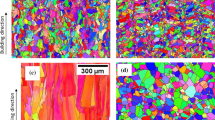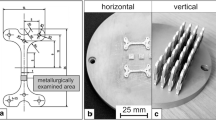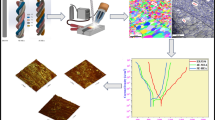Abstract
Microalloyed steels are gaining increasing importance as substitutions for carbon steels because they possess higher mechanical properties, such as strength and toughness after hot forging, without a need for post-deformation heat treatment. To increase machinability, sulfur is added to microalloyed steels to facilitate chip removal, increase productivity, and enhance the life of cutting tools. Otherwise, the sulfide particles that benefit machinability may cause a significant loss in hot workability. Therefore, it is important to understand the effect of initial grain size, phase constituents, and inclusion content on flow stresses during hot working in order to establish ideal processing conditions, which prevent the formation of defects and simultaneously improve mechanical properties. The aim of the current study is to construct processing maps to evaluate the hot workability of microalloyed steels DIN 38MnSiVS5 and 0.39C1.47Mn in order to define the constitutive behavior of both steels under hot working and identify the safe regions for metalworking. The processing maps for both steels showed a region of instability at temperatures between 1100 and 1150 °C and the highest strain rates (namely, 10.0 and 30.0 s−1) that should be avoided. Cracks were found in the sample of 0.39C1.47Mn steel and voids were found in the central region in the DIN 38MnSiVS5 steel. These defects might be caused by MnS inclusions and are probably the cause of instability. Therefore, it can be concluded that a higher sulfur content has a negative effect on workability, and might be the cause of instability under some processing conditions.



















Similar content being viewed by others
References
Bu FZ, Wang XM, Chen L, Yang SW, Shang CJ, Misra RDK (2015) Influence of cooling rate on the precipitation behavior in Ti–Nb–Mo microalloyed steels during continuous cooling and relationship to strength. Mater Charact 102:146–155. doi:10.1016/jmatchar201503005
Zhang X, Cai Q, Zhou G, Chen Q, Xiong Y (2011) Microstructure and mechanical properties of V-Ti–N microalloyed steel used for fracture splitting connecting rod. J Mater Sci 6:1789–1795. doi:10.1007/s10853-010-5002-6
Kim KW, Park JK (2015) A study of the dynamic recrystallization kinetics of V-microalloyed medium carbon steel. J Mater Sci 18:641–6153. doi:10.1016/s10853-015-9171-1
Hajisafari M, Nategh S, Yoozbashizadeh H, Ekrami A (2013) Improvement in mechanical properties of microalloyed steel 30MSV6 by a precipitation hardening process. J Iron Steel Res Int 20:66–73. doi:10.1016/S1006-706X(13)60100-4
Mejía I, Altamirano G, Bedolla-Jacuinde A, Cabrera JM (2014) Modeling of the hot flow behavior of advanced ultra-high strength steels (A-UHSS) microalloyed with boron. Mater Sci Eng A 610:116–125. doi:10.1016/jmsea201404105
Wei H, Liu G, Zhao H, Zhang M (2014) Effect of carbon content on hot deformation behaviors of vanadium microalloyed steels. Mater Sci & Eng A 596:112–120. doi:10.1016/jmsea201312063
Prasad YVRK, Sasidhara S (1997) Hot working guide: a compendium of processing maps. ASM International, Materials Park
Omar AA, Cabrera JM, Prado JM (1996) Characterization of the hot deformation in a microalloyed medium carbon steel using processing maps. Scr Mater 34:1303–1308. doi:10.1016/1359-6462(95)00651-6
Gu S, Zhang L, Ruan J, Zhou P, Zhen Y (2014) Constitutive modeling of dynamic recrystallization behavior and processing map of 38MnVS6 non-quenched steel. J Mater Eng Perform 23:1062–1068. doi:10.1007/s11665-013-0808-4
El Hassani FB, Chenaoui A, Dkiouak R, Elbakkali L, Al Omar A (2008) Characterization of deformation stability of medium carbon microalloyed steel during hot forging using phenomenological and continuum criteria. J Mater Process Technol 199:140–149. doi:10.1016/jjmatprotec200708004
Xu L, Wang C, Liu G, Bai B (2009) Hot deformation behavior of medium carbon V-N microalloyed steel. Trans of Nonferr Met Soc China 19:1389–1394. doi:10.1016/S1003-6326(09)60038-8
Wei H, Liu G (2014) Effect of Nb and C on the hot flow behavior of Nb microalloyed steels. Mater Des 56:437–444. doi:10.1016/jmatdes201311009
Stephenson DA, Agapiou JS (2005) Metal cutting theory and practice. CRC Press, Boca Raton
Bramfitt BL, Benscoter AO (2002) Metallographer’s guide: practice and procedures for irons and steels. ASM International, Materials Park
Opiela M, Kamińska M (2011) Influence of the rare-earth elements on the morphology of non-metallic inclusions in microalloyed steels. J Achiev Mat Manuf Eng 47:149–156
Xiao G, Dong H, Wang M, Hui W (2011) Effect of sulfur content and sulfide shape on fracture ductility in case hardening steel. J Iron Steel Res Int 18:58–64. doi:10.1016/S1006-706X(11)60105-2
Kizu T, Urabe T (2009) Hot ductility of sulfur-containing low manganese mild steels at high strain rate. ISIJ Int 49:1424–1431
Prasad YVRK, Gegel HL, Doraivelu SM, Malas JC, Morgan JT, Lark KA, Barker DR (1984) Modeling of dynamic material behavior in hot deformation-forging of Ti-6242. Metall Trans A 15:1883–1892. doi:10.1007/BF02664902
Lenz M, Gall S, Schmack F, Mayer HM, Reimers W (2014) Hot working behavior of a WE54 magnesium alloy. J Mater Sci 49:1121–1129. doi:10.1007/s10853-013-7790-y
Quan G, Zhao L, Chen T, Wang Y, Mao Y, Lv W, Zhou J (2012) Identification for the optimal working parameters of as-extruded 42CrMo high-strength steel from a large range of strain, strain rate and temperature. Mater Sci Eng A 538:364–373. doi:10.1016/jmsea201201062
Liu Y, Ning Y, Yao Z, Guo H, Nan Y (2014) Effect of true strains on processing map for isothermal compression of Ni-200Cr-25Ti-15Nb-10Al Ni-base superalloy. J Alloys Compd 612:56–63. doi:10.1016/jjallcom201405165
Murty SVS Narayana, Rao BN, Kashyap BP (2005) Identification of flow instabilities in the processing maps of AISI 304 stainless steel. J Mater Process Technol 166:268–278. doi:10.1016/jjmatprotec200409089
Murty SVSN, Rao BN (1998) On the development of instability criteria during hotworking with reference to IN 718. Mater Sci Eng A 254:76–82. doi:10.1016/S0921-5093(98)00764-3
Sneddon IN, Hill R, Naghdi PM, Ziegler H (1963) Progress in solid mechanics. North-Holland Publishing Company, New York
Srinivasan N, Prasad YVRK (1994) Hot-working characteristics of nichrome and the development of a processing map. J Mater Process Technol 41:409–424. doi:10.1016/0924-0136(94)90005-1
Ma XO, Zeng WD, Sun Y, Zhao YQ, Wang SL, Zhou YG (2010) A Comparative study of various flow instability criteria in processing map. Rare Met Mater Eng 39:756–761. doi:10.1016/S1875-5372(10)60096-3
Xu YM, Weins WN, Dhir A (1993) A metallographic investigation of banding and diffusion of phosphorus in steels. Metallogr Characteriz Met Weld Process Serv 20:457–470
Lin YC, Chen MS, Zhong J (2008) Microstructural evolution in 42CrMo steel during compression at elevated temperatures. Mater Lett 62:2132–2135. doi:10.1016/jmatlet200711032
Sun L, Muszka K, Wynne BP, Palmiere EJ (2014) Effect of strain path on dynamic strain-induced transformation in microalloyed steel. Acta Mat 66:132–149. doi:10.1016/j.actamat.2013.11.062
Jorge-Badiola D, Gutierrez I (2004) Study of the strain reversal effect on the recrystallization and strain induced precipitation in a Nb-microalloyed steel. Acta Mat 52:333–341. doi:10.1016/j.actamat.2003.09.018
Ozturk F, Polat A, Toros S, Picu RC (2013) Strain hardening and strain rate sensitivity behaviors of advanced high strength steels. Iron Steel Res Int 20:68–74. doi:10.1016/S1006-706X(13)60114-4
Cyril N, Fatemi A, Cryderman R (2009) Effects of sulfur level and anisotropy of sulfide inclusions on tensile, impact, and fatigue properties of SAE 4140 steel. SAE Int Mater Manuf 1(1):218–227. doi:10.4271/2008-01-0434
Lunev VV, Pirozhkova VP (2012) Nature and diagnostics of nonmetallic inclusions in steels. Russ Metall 6:535–538. doi:10.1134/S0036029512060122
Shevtsova OA, Zyuban NA, Rutskii DV (2011) Aspects of the formation of sulfide inclusions and their effect on the quality of low-alloy structural steels. Metall 54:839–844. doi:10.1007/s11015-011-9382-x
Ma J, Zhang B, Xu DK, Han EH, Ke W (2010) Effects of inclusion and loading direction on the fatigue behavior of hot rolled low carbon steel. Int J Fatigue 32:1116–1125. doi:10.1016/jijfatigue200912005
Luo CH (2001) Evolution of voids close to an inclusion in hot deformation of metals. Comput Mater Sci 21:360–374. doi:10.1016/S0927-0256(01)00149-5
Acknowledgements
The authors wish to thank FAPESP (2012/23273-0 and 2013/23007-0) for the financial support and Advanced Steel Processing and Products Research Center (ASPPRC) at CSM—Colorado School of Mines for the support in samples and equipment usage during the project.
Author information
Authors and Affiliations
Corresponding author
Ethics declarations
Conflict of interest
Authors do not identify any potential conflicts of interest related to this work.
Ethical approval
This research did not involve human participants or animals. No figures, tables, or text passages already published elsewhere were included in this work, therefore no consent or permission was necessary.
Rights and permissions
About this article
Cite this article
da Silva Septimio, R., Button, S.T. & Van Tyne, C.J. Processing maps for the analysis of hot workability of microalloyed steels 38MnSiVS5 and 0.39C1.47Mn. J Mater Sci 51, 2512–2528 (2016). https://doi.org/10.1007/s10853-015-9563-2
Received:
Accepted:
Published:
Issue Date:
DOI: https://doi.org/10.1007/s10853-015-9563-2




